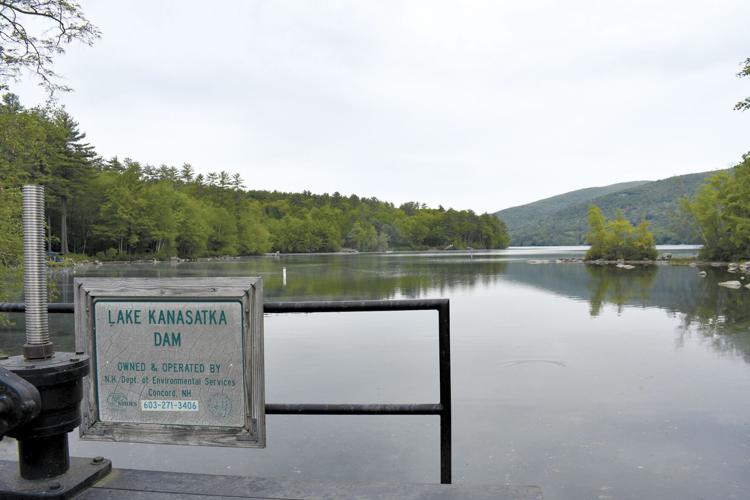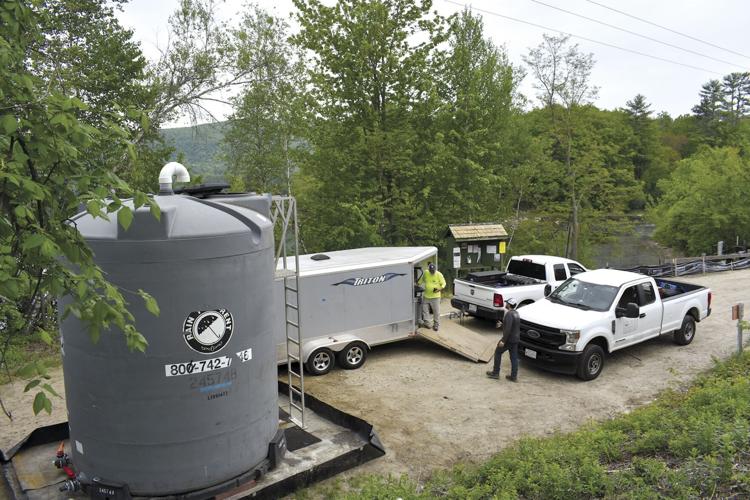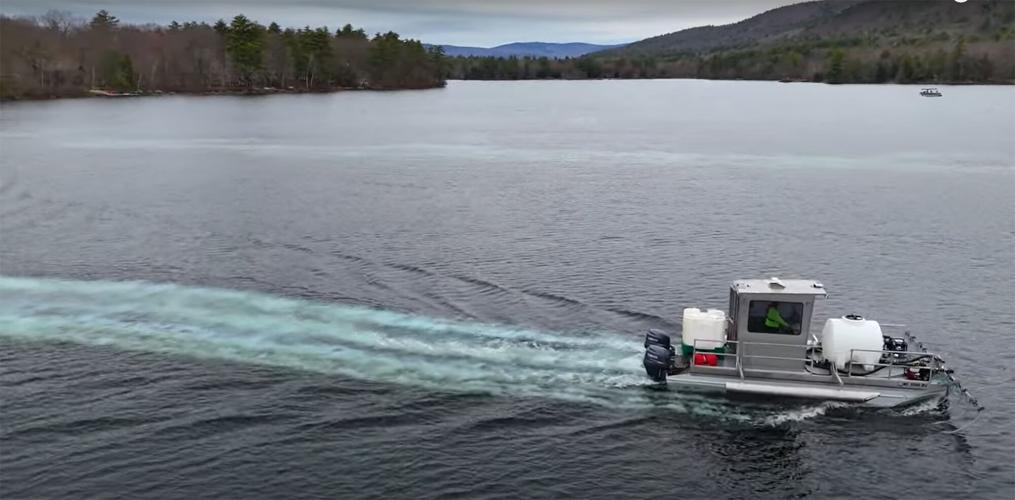MOULTONBOROUGH — This lakeside home has been a part of Kirk Meloney’s family for a half-century, since his parents bought the cottage on Lake Kanasatka in the early 1950s.
“I spent my entire childhood growing up on the lake during the summertime,” said Meloney, now president of the Lake Kanasatka Watershed Association.
Among his childhood memories are moments of playing in crystal clear water, an experience he and his neighbors now know they can’t take for granted. That point was driven home by a lake-wide bloom of green scum in the summer of 2020, which returned for the next three years.
The unpleasant-looking blooms were caused by cyanobacteria, a microorganism that — according to the New Hampshire Department of Environmental Services — is a natural part of a healthy water system. However, when a water system becomes unbalanced, specifically when human activity results in higher levels of phosphorous, the cyanobacteria can form a bloom, transforming clear water into an opaque shade of green.
It’s unpleasant to behold, and concerns go beyond aesthetics. The blooms release a toxin which can be irritating to humans in the short term, and long-term exposure can result in liver, kidney or nervous system damage. The toxin is even more acutely dangerous to pets and other animals.
These blooms are something those who recreate in lakes and ponds are becoming more aware of — there’s a page on the NH DES website at des.nh.gov that describes how to identify a bloom, and report it to the state for monitoring. Typically, though, the blooms are limited in area and last for several days then disappear, perhaps not to reappear again in that same location. But the blooms kept reappearing in Kanasatka, covered much of the lake and stuck around for weeks.
That’s why local advocates were able to convince the state to permit an expensive, unusual treatment which concluded in May that only two other lakes in the state have ever received. Thanks to the treatment, residents are looking forward to their first summer of clear water since 2019.
Internal loading
Phosphorous is a naturally-occurring chemical and an important nutrient in aquatic ecosystems. But natural systems depend on balance, and when too much phosphorous tips the scales, cyanobacteria blooms often result.
Bree Rossiter, conservation program manager for the Lake Winnipesaukee Association, said human activity is often the source of abnormal phosphorous levels. Common culprits are failing or inadequate septic systems, stormwater runoff, lakeside erosion or the indiscriminate application of fertilizer.
When lakes experience a bloom, the source of the phosphorous loading can be hard to impossible to pinpoint. In Kanasatka’s case, though, it was clear something unusual was happening.
“2020 was when things really started to kick off for them in terms of blooms,” Rossiter said. “But last year, 2023, was the worst year they had to date, a total of 127 days of blooms.” The lake was covered in green blooms for almost all of August, but that wasn’t even the worst of it. Another bloom appeared at the end of September, and DES didn’t lift the cyanobacteria advisory for Kanasatka until December.
Kanasatka residents, through their watershed association, discovered the source of the problem. Typically, high phosphorous loads in water bodies are due to external sources, which is why blooms come and go so long as the source is inconsistent. What was happening in Kanasatka, though, was due to “internal loading,” something discovered when samples of the lake bottom were tested.
Testing of the mud and sand at the bottom of lake showed high levels of phosphorous, likely deposited there years or even generations ago, that had bonded to iron in the sediment. When water at the bottom of the lake becomes anoxic — low in oxygen, as typically occurs in late summer — the phosphorous releases from the iron and becomes available for plant and algae consumption.
The Lake Kansatka Watershed Association had developed a management plan to mitigate any external phosphorous sources, but that wouldn’t address the cache on the lake bed waiting to be released. The organization proposed an extraordinary remedy: seed the lake with aluminum sulfate, which will permanently bond with phosphorous, thus solving the lake’s problematic legacy.
Not only did the state approve the application, DES awarded the project a $500,000 grant to help pay for it. The watershed association covered the rest of the $868,000 cost through fund raising and in-kind donations.
Urgent concern
Only two other lakes in the state — Kezar Lake in 1984 and Nippo Lake more recently — have been approved for aluminum sulfate treatment. It’s an unusual treatment, but Ted Diers with DES called the situation at Kanasatka unusually concerning.
“Lake Kanasatka has suffered from some pretty significant cyanobacteria blooms over the past few years, that seem increasingly severe,” said Diers, assistant director of the DES Water Division. “It’s a public health issue, it’s also a recreational issue.”
Diers said the problem was spreading beyond Kanasatka. Last fall, the bloom was present not just in the lake where it was most prevalent, but also in Blackey Cove in Lake Winnipesaukee, into which Kanasatka drains.
“[That] made it a much more urgent concern,” Diers said.
Even so, the approval from the state to treat the lake with alum was more than just a question of need. There was also the seriousness of the applicants, Diers said.
“A number of other factors came together. The Lake Kanasatka Watershed Association has done a very good job of understanding this question,” Diers said, citing studies that concluded the phosphorous was stored in the lake bottom, and the creation of a management plan that identifies and addresses possible sources for new phosphorous introduction.
“They did some very good studies understanding where those nutrients are coming from, and they’ve worked vey hard to reduce those nutrients,” Diers said.
He noted the state monitors the application of aluminum sulfate during and immediately after the treatment to look for detrimental effects on the ecosystem. “So far, it’s been great, and at other lakes where this has been done, we haven’t seen any negative effects.”
It’s hard to say how long the phosphorous has been stored in the bottom of Kanasatka, and it’s equally hard to say why it suddenly became a problem in 2020. However, Diers said, there are lots of possible explanations.
“Certainly there’s been more development over the past 50, 60 years. We know that temperatures are rising, we know that ice-out is earlier and ice-in is later. All of those factors, as well as precipitation patterns, the use of the lake, these are all things that have an impact on water quality,” Diers said. “To try and understand which of those is the cause is very challenging.”
Constant education
The Lake Kanasatka Watershed Association has been busy over the past few years. “It was a long road in a short amount of time to get where we got,” said Meloney. “It was a successful treatment, and we’re looking forward to a cyanobacteria-free lake this year as well as many years to come.”
As effective as alum treatment is, it only addresses phosphorous present at the time of application. Meloney said last month’s treatment is only one element of broader plan.
“Part of the battle is addressing what’s in the lake already. The bigger battle is addressing the runoff so we don’t continue to see this phosphorous going into the water,” Meloney said. “It’s a constant education with people that own shorefront property, best practices and things you can do to maintain lake health. We’ll be educating for years to come, as well as to address runoff situations from around the lake, which need to be revamped and addressed so the lake doesn’t receive so much runoff.”
Meloney said his association does have one advantage they can leverage. Everyone seems to share the same affection for the lake, making it easy to bring people into the coalition of water quality stewardship.
“The network of property owners in and around Kanasatka, many of them have a long family history, like myself, growing up on the lake, enjoying the clean water. I want to provide the same thing for my grandkids,” Meloney said. "It’s important to me, as well as to a lot of other people around the lake, to preserve, to be able to pass down a clean body of water to the next generation to enjoy just as we did.
"If our water quality goes south, what do we have? Nothing.”






















(0) comments
Welcome to the discussion.
Log In
Keep it Clean. Please avoid obscene, vulgar, lewd, racist or sexually-oriented language.
PLEASE TURN OFF YOUR CAPS LOCK.
Don't Threaten. Threats of harming another person will not be tolerated.
Be Truthful. Don't knowingly lie about anyone or anything.
Be Nice. No racism, sexism or any sort of -ism that is degrading to another person.
Be Proactive. Use the 'Report' link on each comment to let us know of abusive posts.
Share with Us. We'd love to hear eyewitness accounts, the history behind an article.